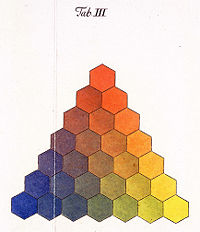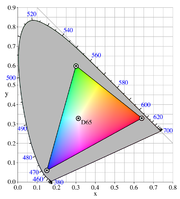
Color triangle
Encyclopedia


Color
Color or colour is the visual perceptual property corresponding in humans to the categories called red, green, blue and others. Color derives from the spectrum of light interacting in the eye with the spectral sensitivities of the light receptors...
s within a triangle
Triangle
A triangle is one of the basic shapes of geometry: a polygon with three corners or vertices and three sides or edges which are line segments. A triangle with vertices A, B, and C is denoted ....
, based on the additive
Additive color
An additive color model involves light emitted directly from a source or illuminant of some sort. The additive reproduction process usually uses red, green and blue light to produce the other colors. Combining one of these additive primary colors with another in equal amounts produces the...
combination of three primary color
Primary color
Primary colors are sets of colors that can be combined to make a useful range of colors. For human applications, three primary colors are usually used, since human color vision is trichromatic....
s at its corners.
An additive color space
Color space
A color model is an abstract mathematical model describing the way colors can be represented as tuples of numbers, typically as three or four values or color components...
defined by three primary colors has a chromaticity
Chromaticity
Chromaticity is an objective specification of the quality of a color regardless of its luminance, that is, as determined by its hue and colorfulness ....
gamut
Gamut
In color reproduction, including computer graphics and photography, the gamut, or color gamut , is a certain complete subset of colors. The most common usage refers to the subset of colors which can be accurately represented in a given circumstance, such as within a given color space or by a...
that is a color triangle, when the amounts of the primaries are constrained to be nonnegative.
Before the theory of additive color was proposed by Thomas Young
Thomas Young (scientist)
Thomas Young was an English polymath. He is famous for having partly deciphered Egyptian hieroglyphics before Jean-François Champollion eventually expanded on his work...
and further developed by James Clerk Maxwell
James Clerk Maxwell
James Clerk Maxwell of Glenlair was a Scottish physicist and mathematician. His most prominent achievement was formulating classical electromagnetic theory. This united all previously unrelated observations, experiments and equations of electricity, magnetism and optics into a consistent theory...
and Hermann von Helmholtz
Hermann von Helmholtz
Hermann Ludwig Ferdinand von Helmholtz was a German physician and physicist who made significant contributions to several widely varied areas of modern science...
, triangles were also used to organize colors, for example around a system of red, yellow, and blue primary colors
RYB color model
RYB is a historical set of colors used in subtractive color mixing, and is one commonly used set of primary colors...
.
After the development of the CIE system
CIE 1931 color space
In the study of color perception, one of the first mathematically defined color spaces is the CIE 1931 XYZ color space, created by the International Commission on Illumination in 1931....
, color triangles were used as chromaticity diagrams, including briefly with the trilinear coordinates
Trilinear coordinates
In geometry, the trilinear coordinates of a point relative to a given triangle describe the relative distances from the three sides of the triangle. Trilinear coordinates are an example of homogeneous coordinates...
representing the chromaticity values. Since the sum of the three chromaticity values has a fixed value, it suffices to depict only two of the three values, using Cartesian co-ordinates. In the modern x,y diagram, the large triangle bounded by the imaginary primaries X, Y, and Z has corners (1,0), (0,1), and (0,0), respectively; color triangles with real primaries are often shown within this space.
Maxwell's disc
Maxwell was intrigued by James David ForbesJames David Forbes
James David Forbes was a Scottish physicist and glaciologist who worked extensively on the conduction of heat and seismology. Forbes was a resident of Edinburgh for most of his life, educated at the University and a professor there from 1833 until he became principal of the United College of St...
's use of color top
Top
A top is a toy that can be spun on an axis, balancing on a point. This motion is produced in the most simple forms of top by twirling the stem using the fingers. More sophisticated tops are spun by by holding the axis firmly while pulling a string or twisting a stick or pushing an auger as shown...
s. By rapidly spinning the top, Forbes created the illusion of a single color that was a mixture of the primaries:
Maxwell took this a step further by using a circular scale around the rim with which to measure the ratios of the primaries, choosing vermilion
Vermilion
Vermilion is an opaque orangish red pigment, similar to scarlet. As a naturally occurring mineral pigment, it is known as cinnabar, and was in use around the world before the Common Era began. Most naturally produced vermilion comes from cinnabar mined in China, and vermilion is nowadays commonly...
(V), emerald (EG), and ultramarine
Ultramarine
Ultramarine is a blue pigment consisting primarily of a double silicate of aluminium and sodium with some sulfides or sulfates, and occurring in nature as a proximate component of lapis lazuli...
(U).
Initially, he compared the color he observed on the spinning top with a paper of different color, in order to find a match. Later, he mounted a pair of papers, snow white (SW) and ivory black (Bk), in an inner circle, thereby creating shades of gray. By adjusting the ratio of primaries, he matched the observed gray of the inner wheel, for example:

To determine the chromaticity of an arbitrary color, he replaced one of the primaries with a sample of the test color and adjusted the ratios until he found a match. For pale chrome (PC) he found
 . Next, he rearranged the equation to express the test color (PC, in this example) in terms of the primaries.
. Next, he rearranged the equation to express the test color (PC, in this example) in terms of the primaries.This would be the precursor to the color matching functions of the CIE 1931 color space
CIE 1931 color space
In the study of color perception, one of the first mathematically defined color spaces is the CIE 1931 XYZ color space, created by the International Commission on Illumination in 1931....
, whose chromaticity diagram is shown above.

